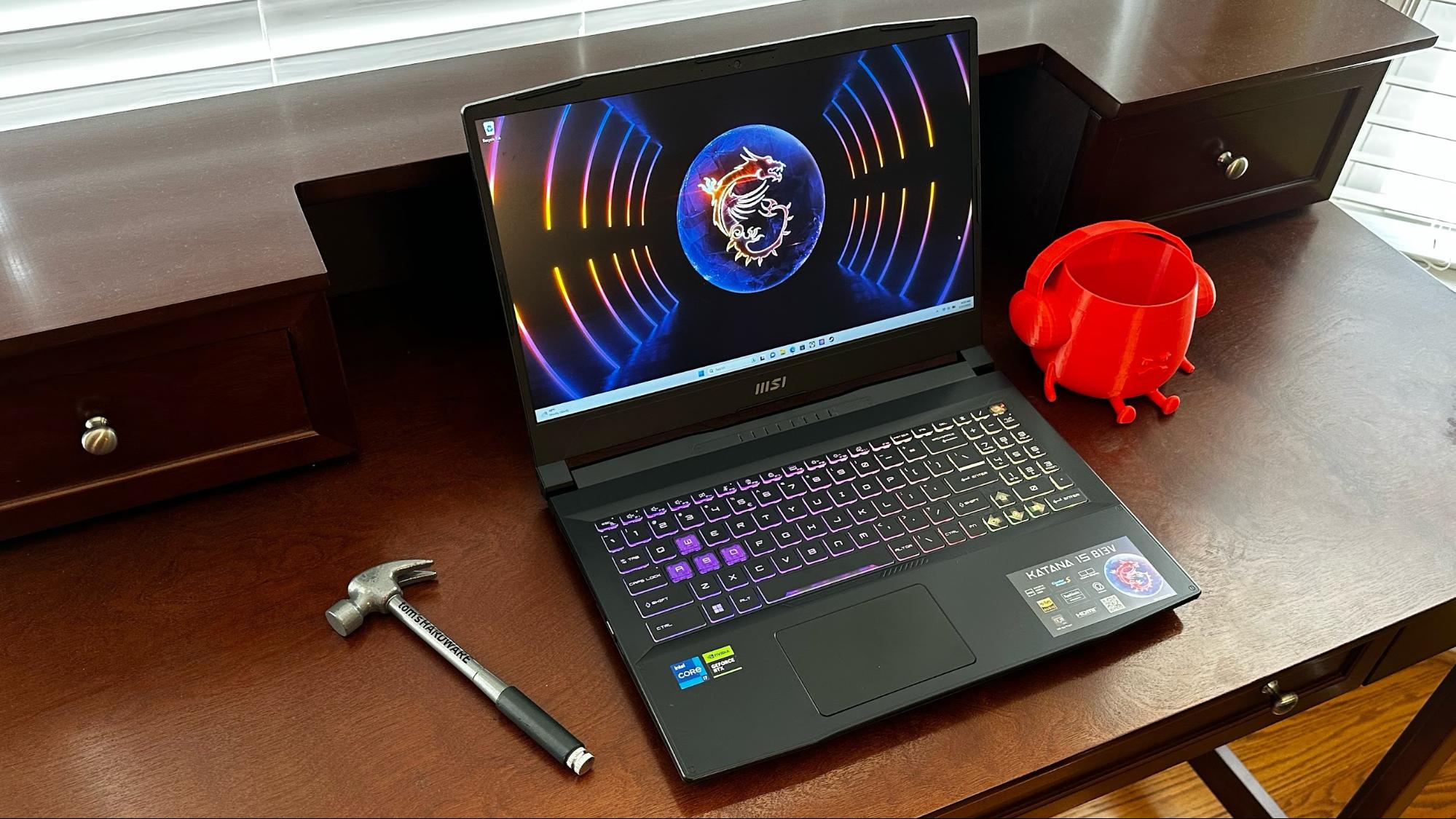
Gaming laptops are very popular among those who want a portable gaming PC, and there are countless options available to suit your specific needs. If you want the absolute best hardware that money can buy, you can easily spend thousands of dollars on a premium gaming laptop. However, not everyone is willing to throw down a mortgage payment (or two) on a gaming laptop and can get by with something much less powerful.
Thankfully, the under $1,000 gaming laptop field is rife with competition and is now joined by the new MSI Katana 15. Our Katana 15 review unit just barely squeaks by the cutoff at $999 (as configured). Still, it manages to cram in a lot of bang for the buck with an Intel Raptor Lake processor, Nvidia GeForce RTX 40 discrete graphics card, 16GB of RAM and a generous 1TB SSD.
If you’re willing to make a few compromises, the Katana 15 is a worthwhile entry to the best gaming laptops under $1,000.
Design of the MSI Katana 15
A lot is going on with the design of the Katana 15. The laptop is constructed of high-sheen plastic all around, with a high level of flex in the display lid and keyboard deck. MSI imprints its logo into the lid and includes fake flathead screw embellishments around the keyboard deck. Pixel-style design elements are also imprinted under the display, along the edge of the display lid and on the sides of the chassis (you can see it prominently near the USB ports in the images below). While the overall feel of the laptop is “cheap,” it’s right in line with what we expect from laptops in this price category.

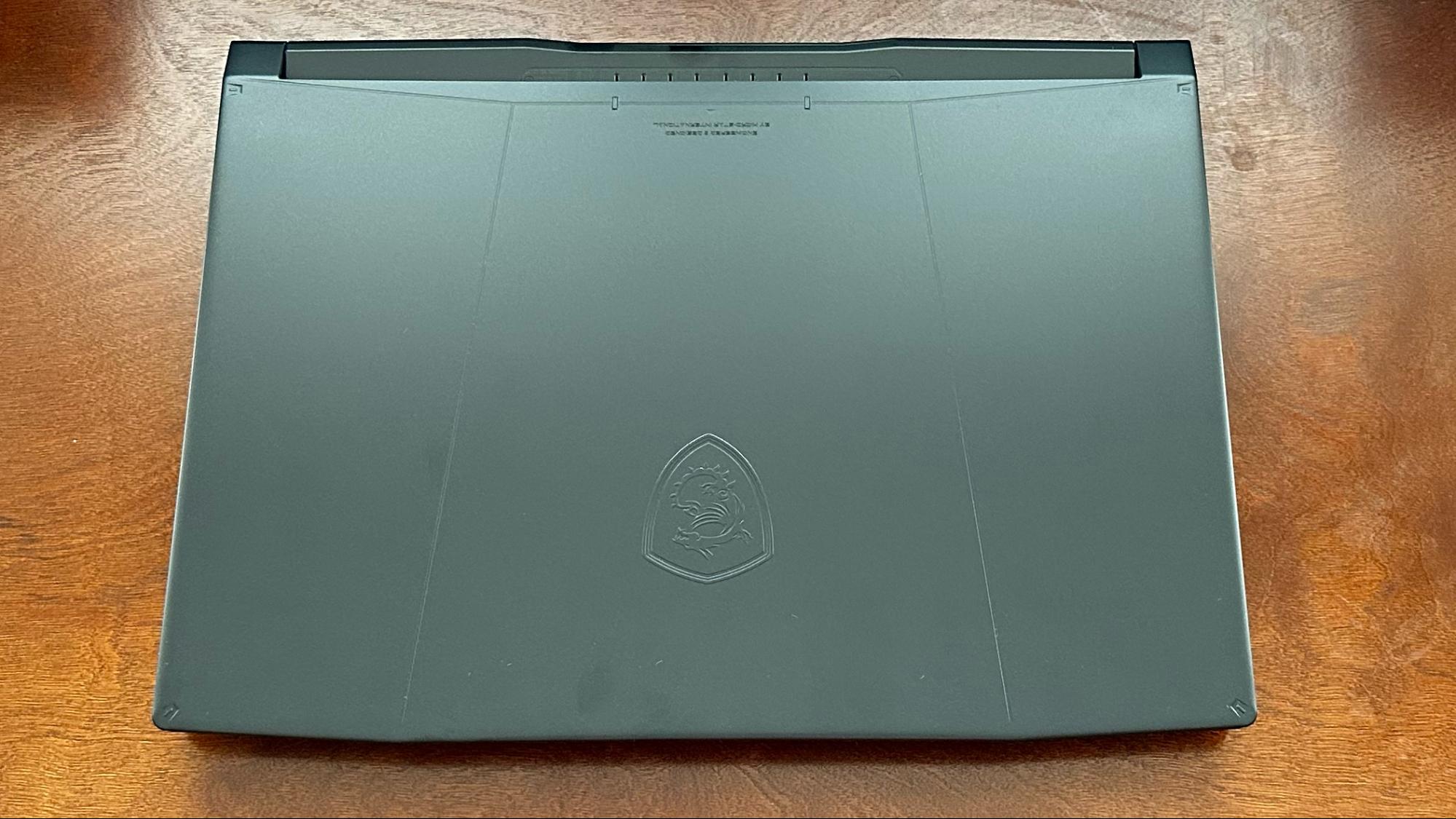
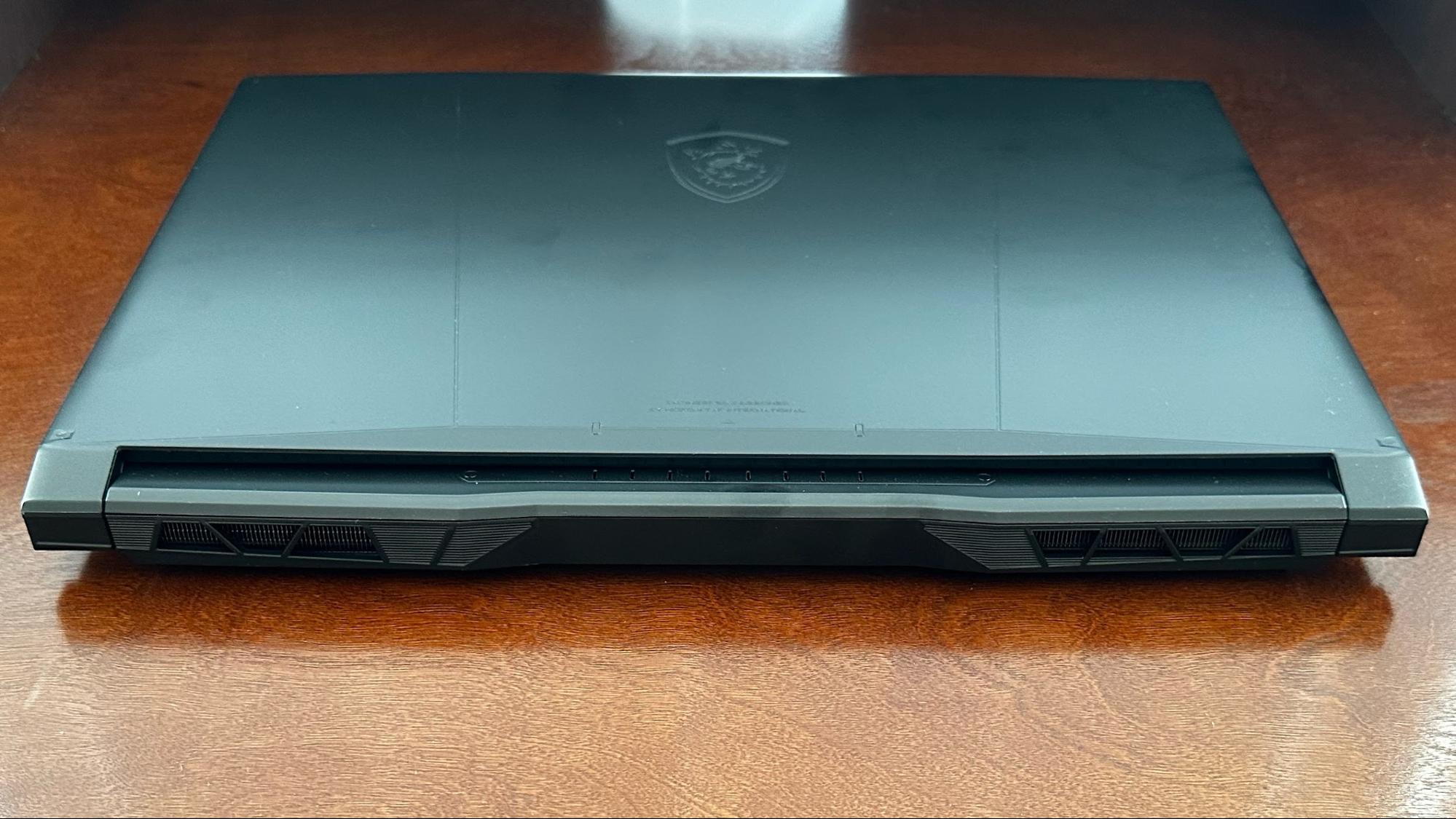
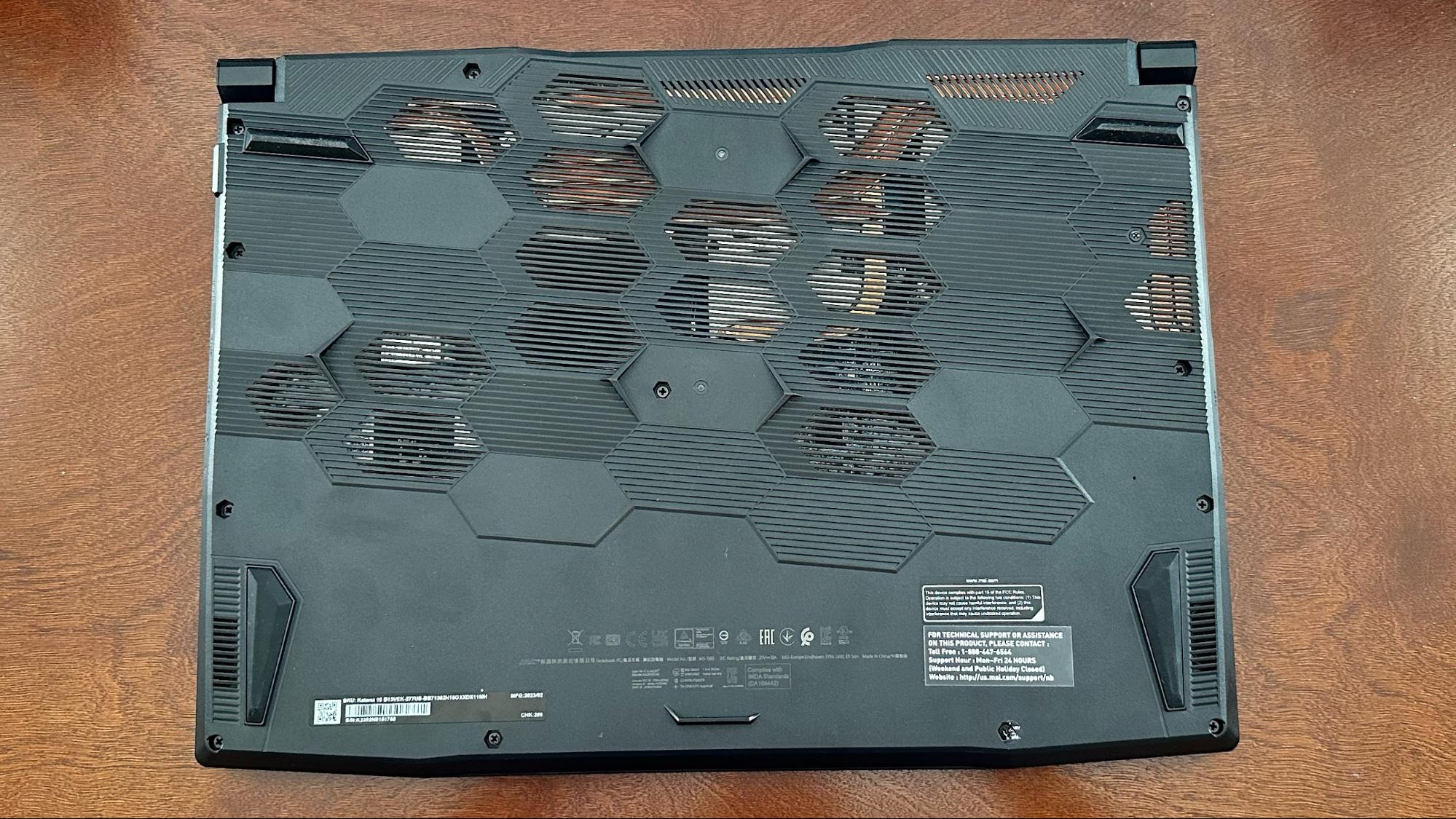
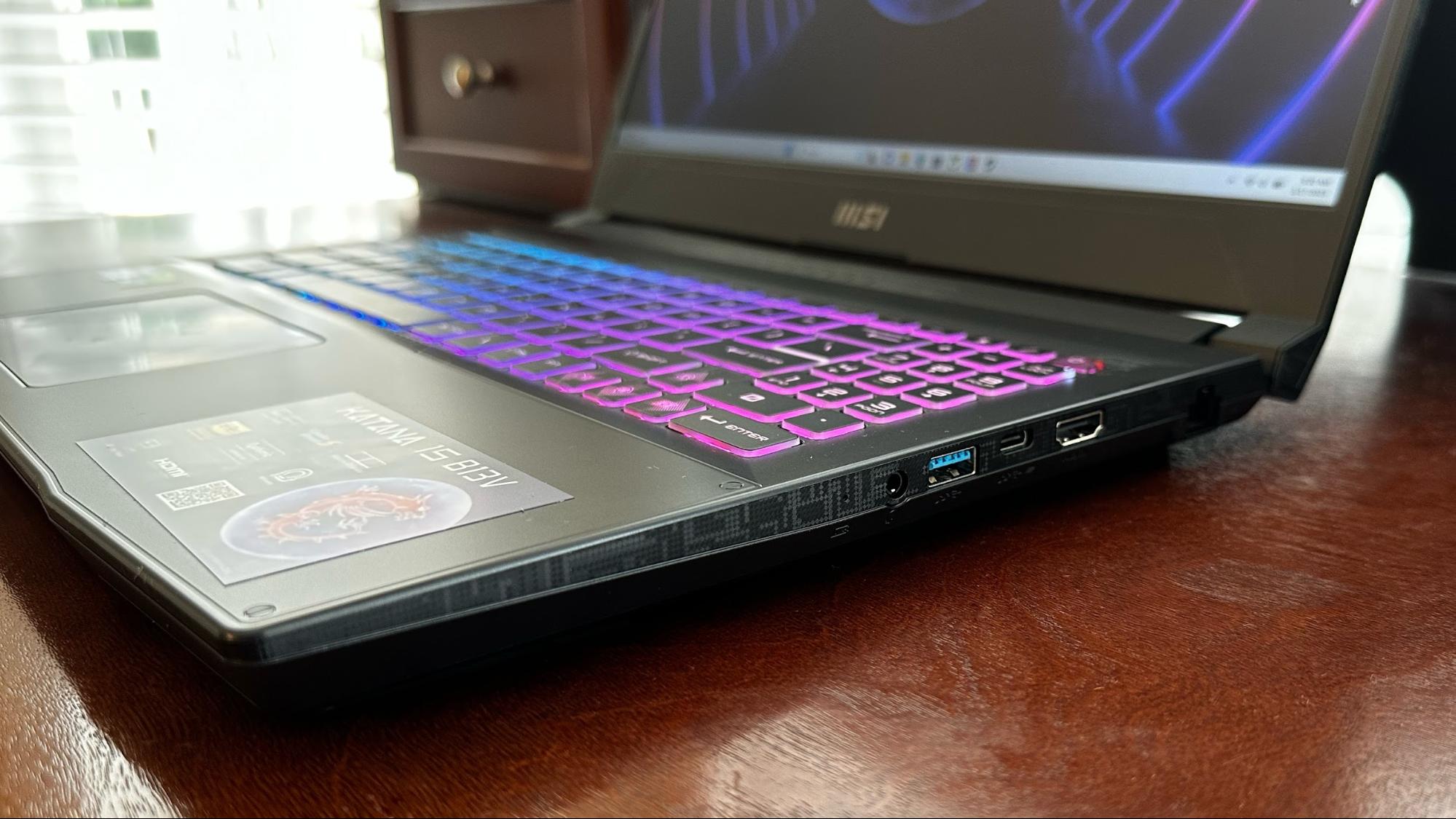
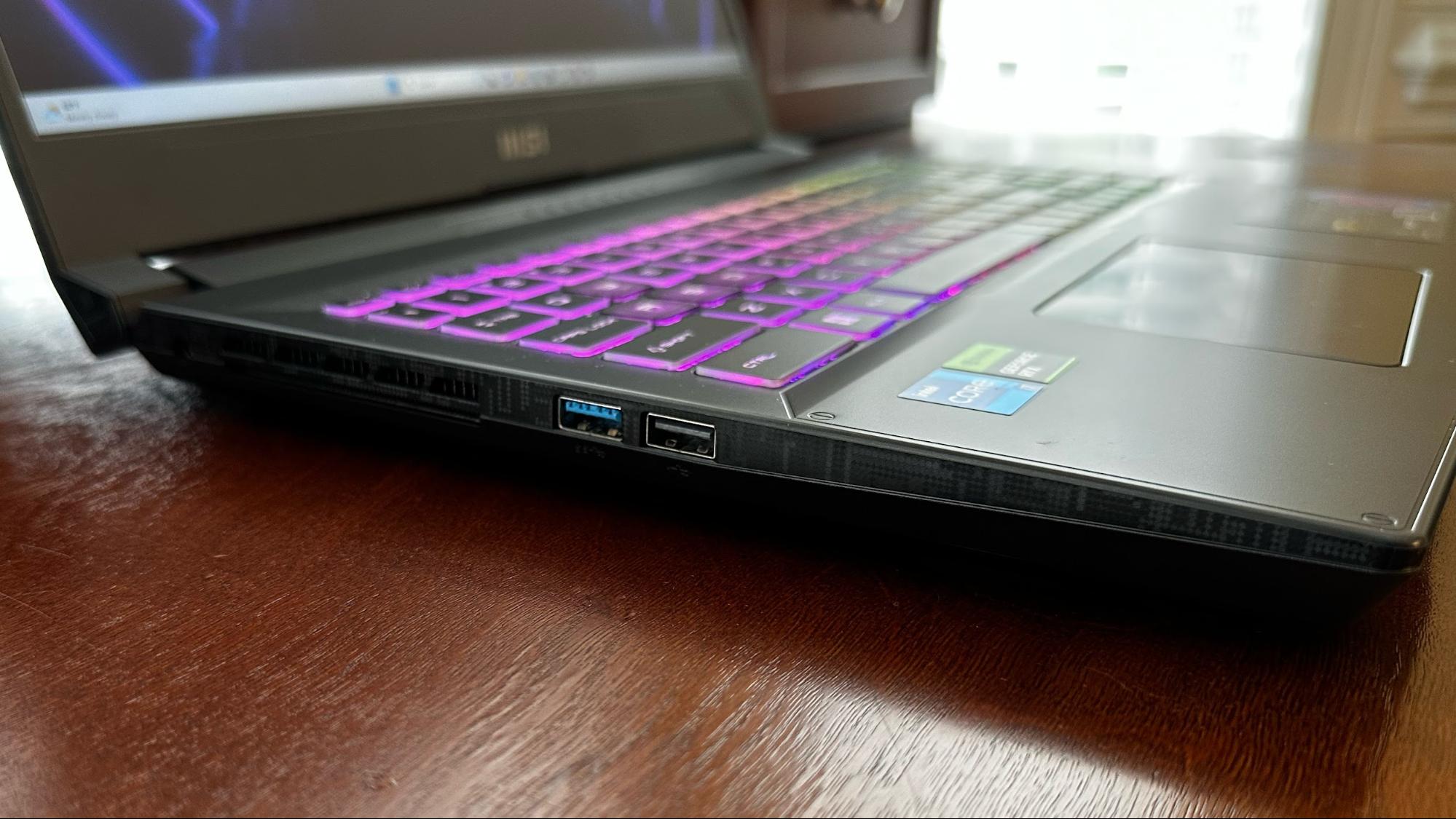
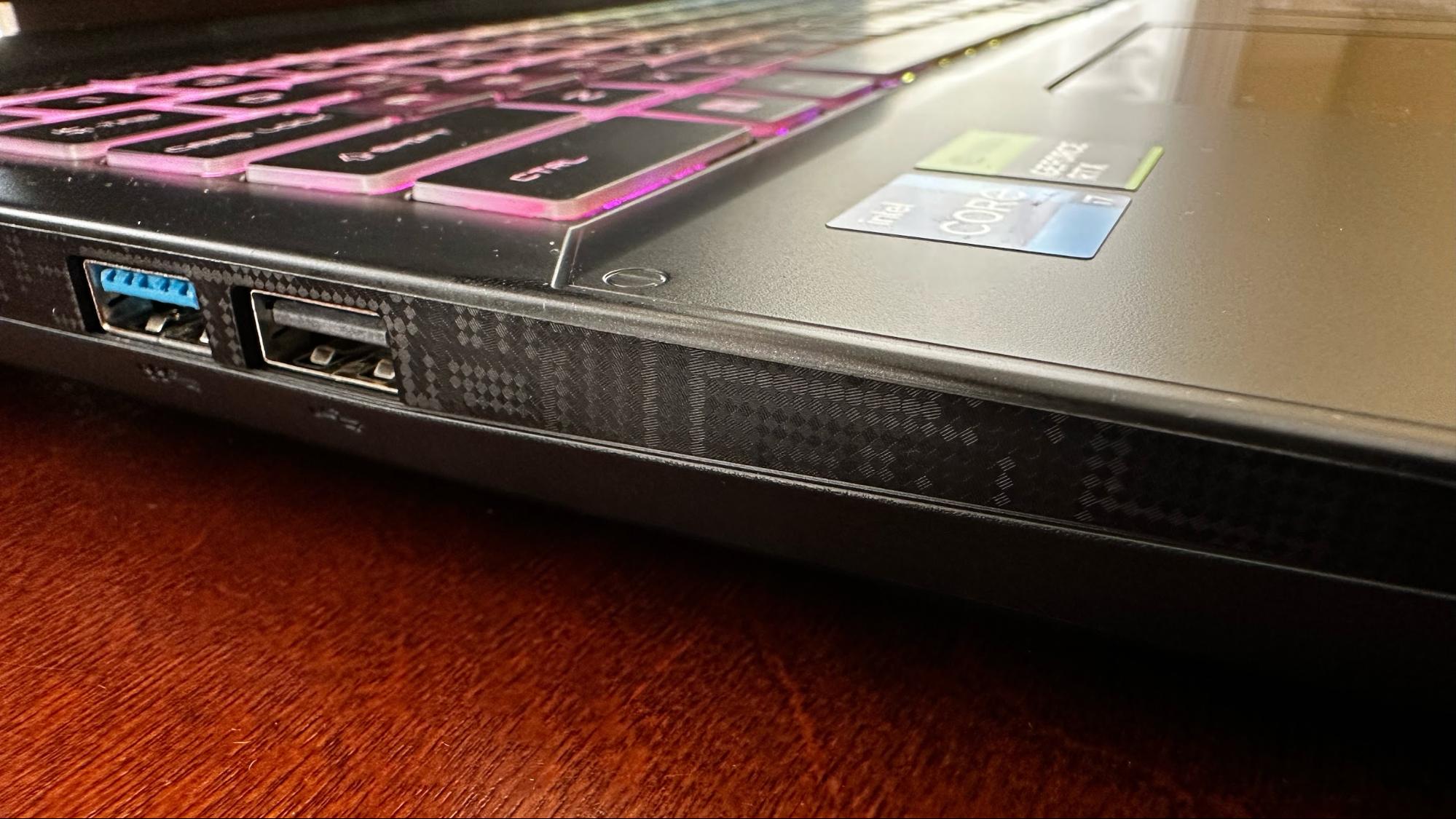
However, the most daring design choice is the four-zone RGB keyboard, which uses an off-beat font and more pixel elements between the keys near the number pad. The WASD and power keys are transparent, allowing you to see the scissor switches beneath. I’m not a fan of the arrow keys with their eccentric prints that are too busy.
The right side of the chassis is home to an Ethernet jack, HDMI 2.1, USB 3.2 Type-A and USB 3.2 Type-C ports. On the opposite side, you’ll find another USB 3.2 Type-A port, a USB 2.0 port and a proprietary power receptacle for a barrel-style plug.
The Katana 15 measures 14.13 x 10.20 x 0.98 inches and weighs 4.96 pounds, putting it on the lighter side in this grouping. For comparison, the Lenovo IdeaPad Gaming 3 measures 14.16 x 10.49 x 0.86 inches and weighs 5.51 pounds, while the Dell G15 (5520) comes in at 14.1 x 10.8 x 1.1 inches and 5.5 pounds. The Acer Nitro 5 weighs 5.51 pounds and measures 14.19 x 10.67 x 1.06 inches.
MSI Katana 15 Specifications
Gaming Performance on the MSI Katana 15
Our MSI Katana 15 review was nicely equipped with an Intel Core i7-13620H Raptor Lake processor, an entry-level GeForce RTX 4050 GPU, 16GB of DDR5-5200 RAM (2 x 8GB) and a 1TB M.2 PCIe SSD. We saw frame rates hover around 70 to 80 fps in the games we tested at 1080p resolution and high detail settings enabled.
We expect machines like these to target the esports community, and the Katana 15 can hold its own in Overwatch 2. I spent an hour blasting folks in Overwatch 2 with 1080p Ultra settings. The Katana 15 hit the 144 fps limit of the 144 Hz display and maintained that performance throughout multiplayer gaming sessions. I also played Cyberpunk 2077 at 1080p with Ultra-RT settings with DLSS DG and DLSS SR (Quality), averaging around 70 fps.
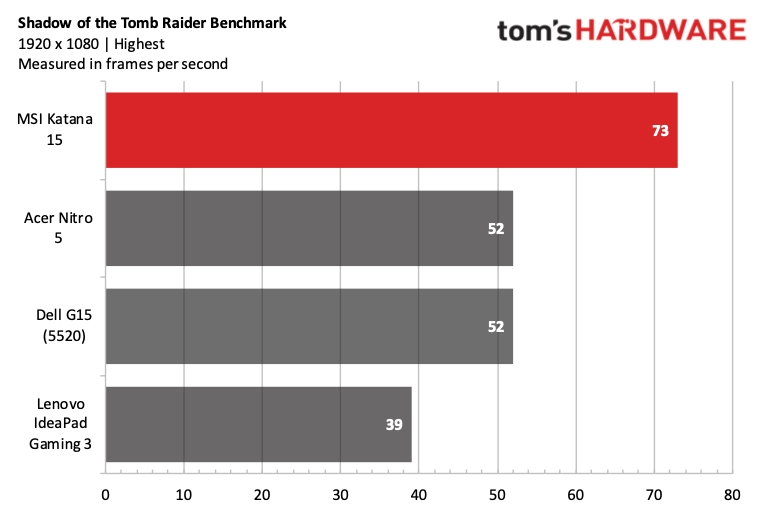
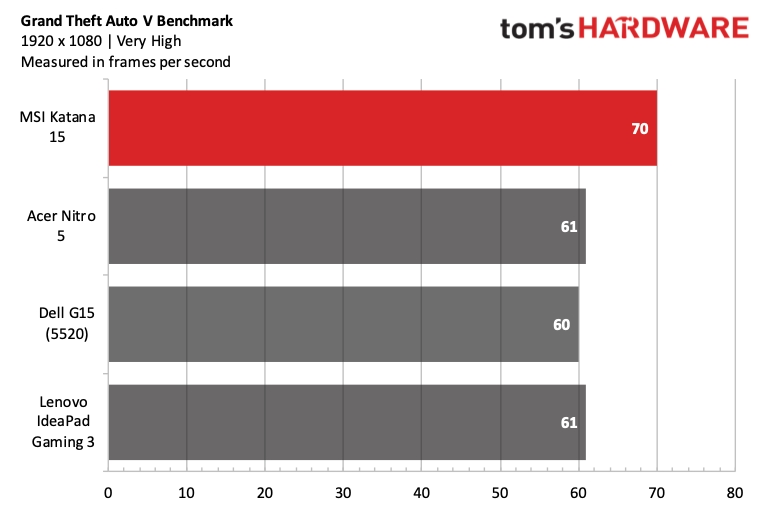
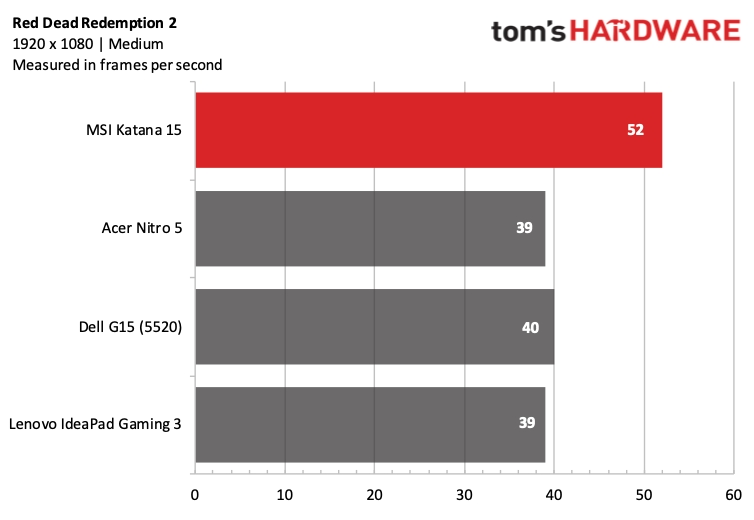
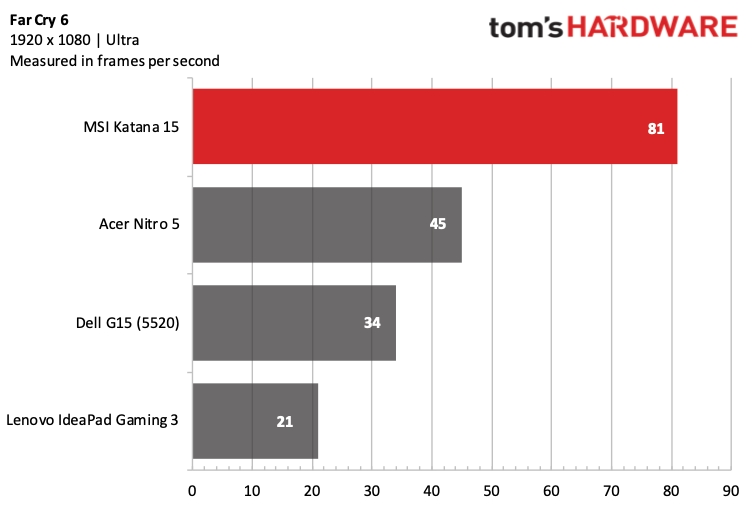
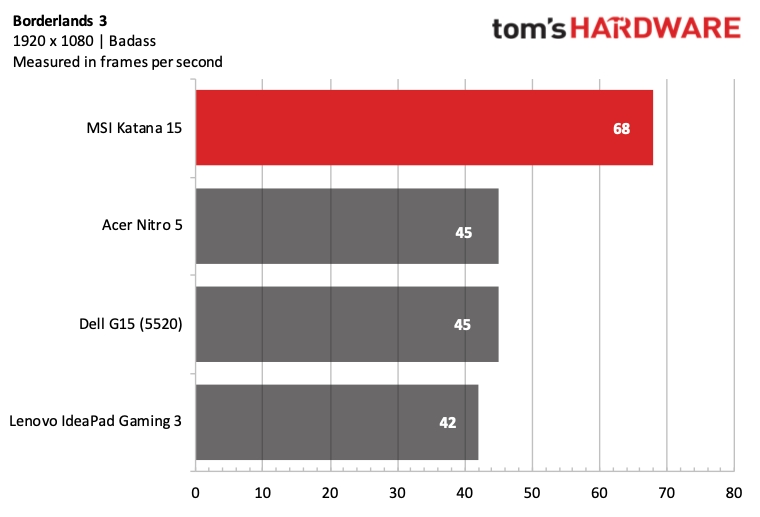
The Shadow of the Tomb Raider (highest) benchmark saw the Katana 15 pull out a commanding lead at 73 frames per second at 1080p resolution. The Acer Nitro 5 (Core i5-12500H, RTX 3050 Ti) and Dell G15 (Core i5-12500H, RTX 3050 Ti) tied for second place at 52 fps. The Lenovo IdeaPad Gaming 3 (Core i5-12500H, RTX 3050 Ti) pulled up the rear with 39 fps. For reference, a Lenovo Legion Pro 5i (Core i7-13700, RTX 4060) hits 107 fps in this benchmark at 1080p.
Switching gears to Grand Theft Auto V (very high), the Katana 15 again landed in the top spot with 70 fps. The Nitro 5 and IdeaPad Gaming 3 hit 61 fps, while the G15 was just a step behind at 60 fps.
The Katana 15 stretched its legs in Far Cry 6 (ultra), delivering a heady (for a sub-$1,000 machine) 81 fps. The Nitro 5 was the next-closest challenger at 45 fps, while the IdeaPad Gaming 3 pulled up the rear of the pack at a meager 21 fps.
It was a similar situation with Red Dead Redemption 2 (Medium), where the Katana 15 delivered 52 fps compared to 40 fps for the G15. The Nitro 5 and IdeaPad Gaming 3 were just behind at 39 fps.
Finally, the Borderlands 3 benchmark (Badass) saw the Katana open a 23-fps advantage (68 fps) over the Nitro 5 and G15. If you’re wondering how an RTX 4060 would perform on this benchmark, the Legion Pro 5i hits 90 fps.
In addition to our standing game benchmark suite, we also stress-test gaming laptops by running the Metro Exodus benchmark (RTX Setting) through 15 loops. The Katana 15 averaged 57.78 fps during the 15 runs.
During the Metro Exodus stress test, the Core i7-13620H’s performance and efficiency cores averaged 4.54 GHz and 3.33 GHz, respectively, and the CPU package measured 77.98 degrees Celsius (172.36 degrees Fahrenheit). Meanwhile, the GeForce RTX 4050 had an average clock speed of 2.27 GHz and measured at 72.22 C (161.99 F).
Productivity Performance on the MSI Katana 15
Our MSI Katana 15 review unit has a Core i7-13620H processor, 16GB of DDR5-5200 RAM and a 1TB SSD.
Geekbench 5 is a showcase for synthetic CPU performance, and here the Katana 15 easily outpaced the Core i5-12700H processor found in each of its three competitors in this field with a single-core score of 1,787. The performance difference was magnified in the multi-core benchmark, where the Katana 15 scored 12,017 compared to the next-best Acer Nitro 5 at 9,148.
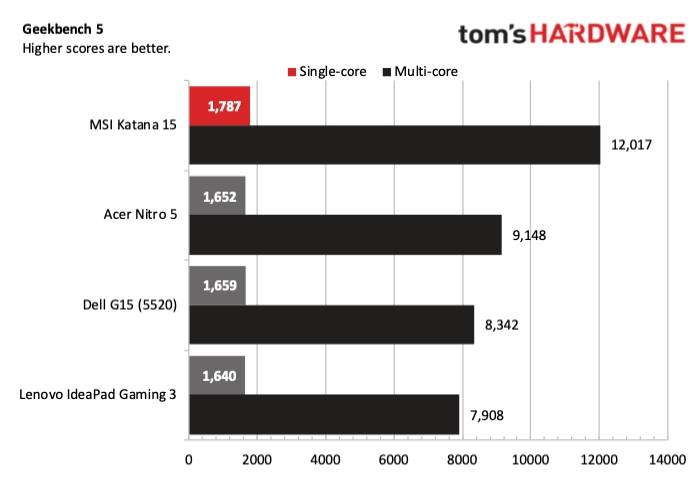
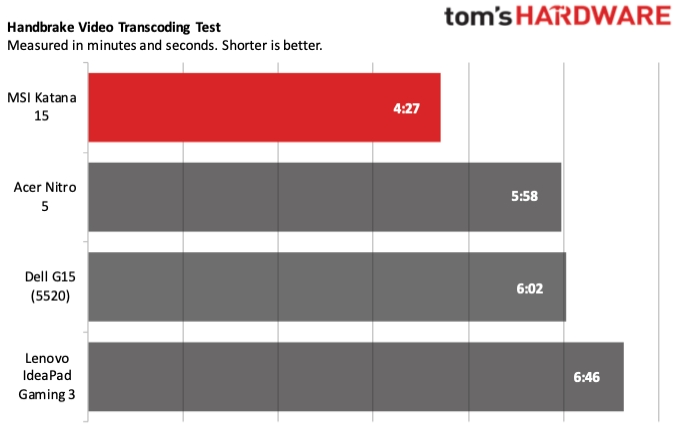
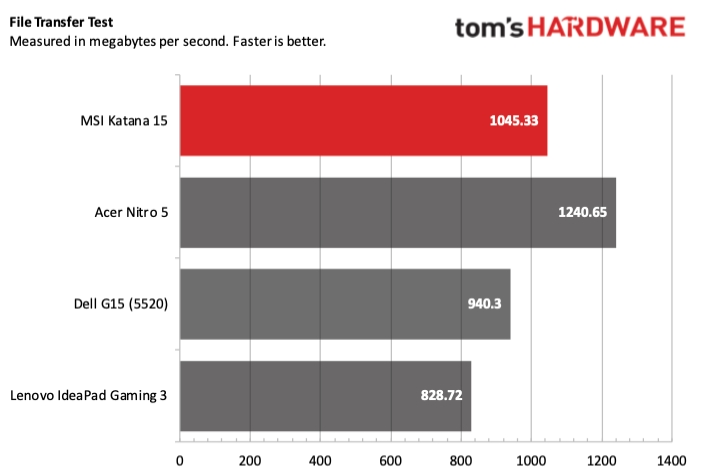
We use Handbrake to transcode a 4K video to 1080p, and the Katana 15 accomplished the feat in four minutes and 27 seconds. The next-closest competitor finished in five minutes and 58 seconds, while the slowest, the IdeaPad Gaming 3, took six minutes and 46 seconds.
The Katana 15’s SSD hit 1,045.33 MBps during our 25GB file copy test. While this was good enough for second place, the Nitro 5 topped all competitors at 1,240.65 MBps.
Display on the MSI Katana 15
The MSI Katana 15 uses a 15.6-inch IPS panel with a 1080p resolution and a fast 144Hz refresh rate. When looking straight-on, the screen is reasonably bright (we measured 250 nits using our light meter), with a slight drop in brightness at extreme angles to the left or right.
We weren’t expecting world-class display performance in the sub-$1,000 segment, and that holds true with the Katana 15. According to our colorimeter, the Katana 15 could only reach 49 percent DCI-P3 coverage, while it hit 69 percent of the sRGB color gamut. That is right in line with the segment averages in those respective categories. However, the 250 nits brightness measurement put it in last place in this grouping, while the Acer Nitro 5 took top honors at 314 nits.
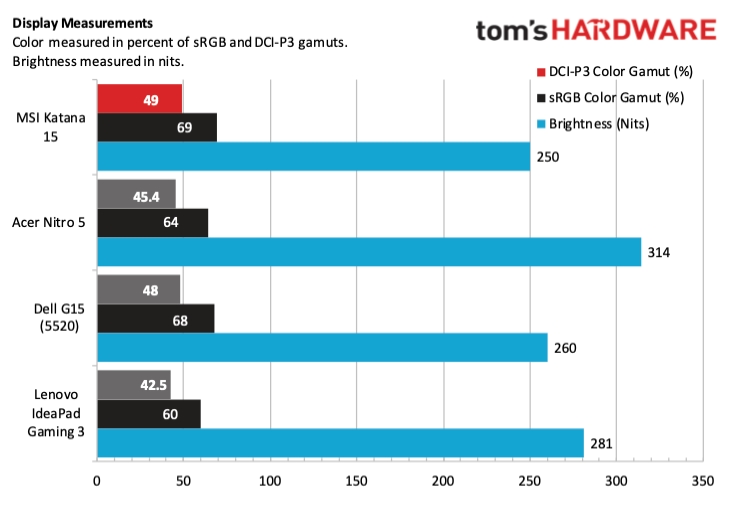
Despite the disadvantage on paper, I had no trouble with the legibility of the display with numerous overhead lights in a home office setting or outside on an overcast day. However, while seeing what was on the screen was not a problem, the picture quality was a different matter. From YouTube videos to games to Disney Plus programming, the colors presented on the Katana 15’s display seemed muted. MSI is prioritizing a high refresh rate to appease gamers over outright quality, and it shows.
I re-watched the Guardians of the Galaxy Holiday Special and noticed the muted greens and red of Drax’s Christmas sweater and the overall lack of richness to the scenes. The color downgrade wasn’t as apparent in a game like Overwatch 2, as its colors are already tuned to a more cartoonish representation than attempting to pass for real-life imagery.
Keyboard and Touchpad on the MSI Katana 15
The keyboard on the Katana 15 felt comfortable under my fingers and offered good feedback. The keyboard has four-zone RGB lightning, allowing you to choose from Steady, Breath, Color Cycle and Wave options. You can also choose your own customized theme, if you prefer, using the MSI Center app.
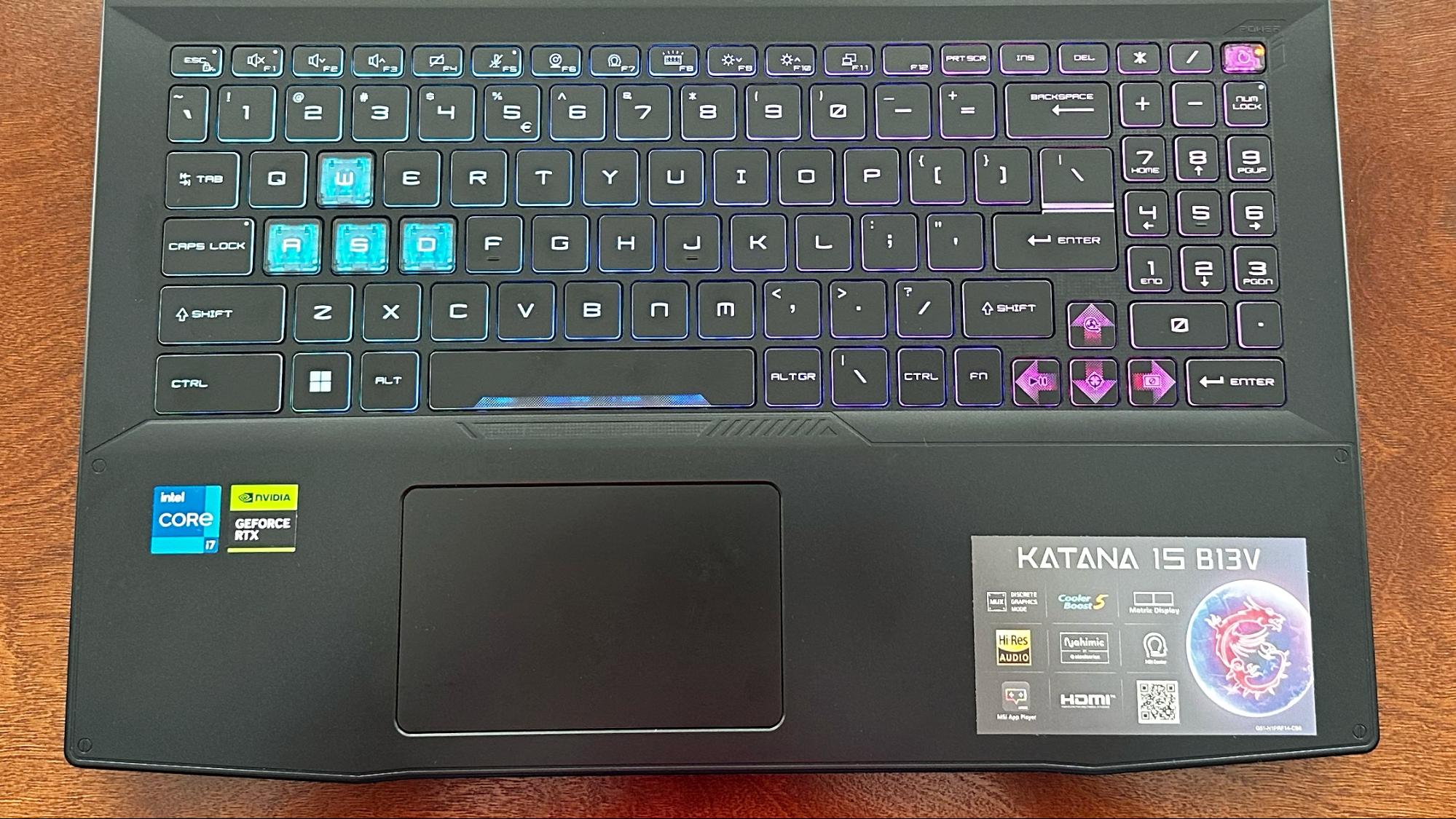
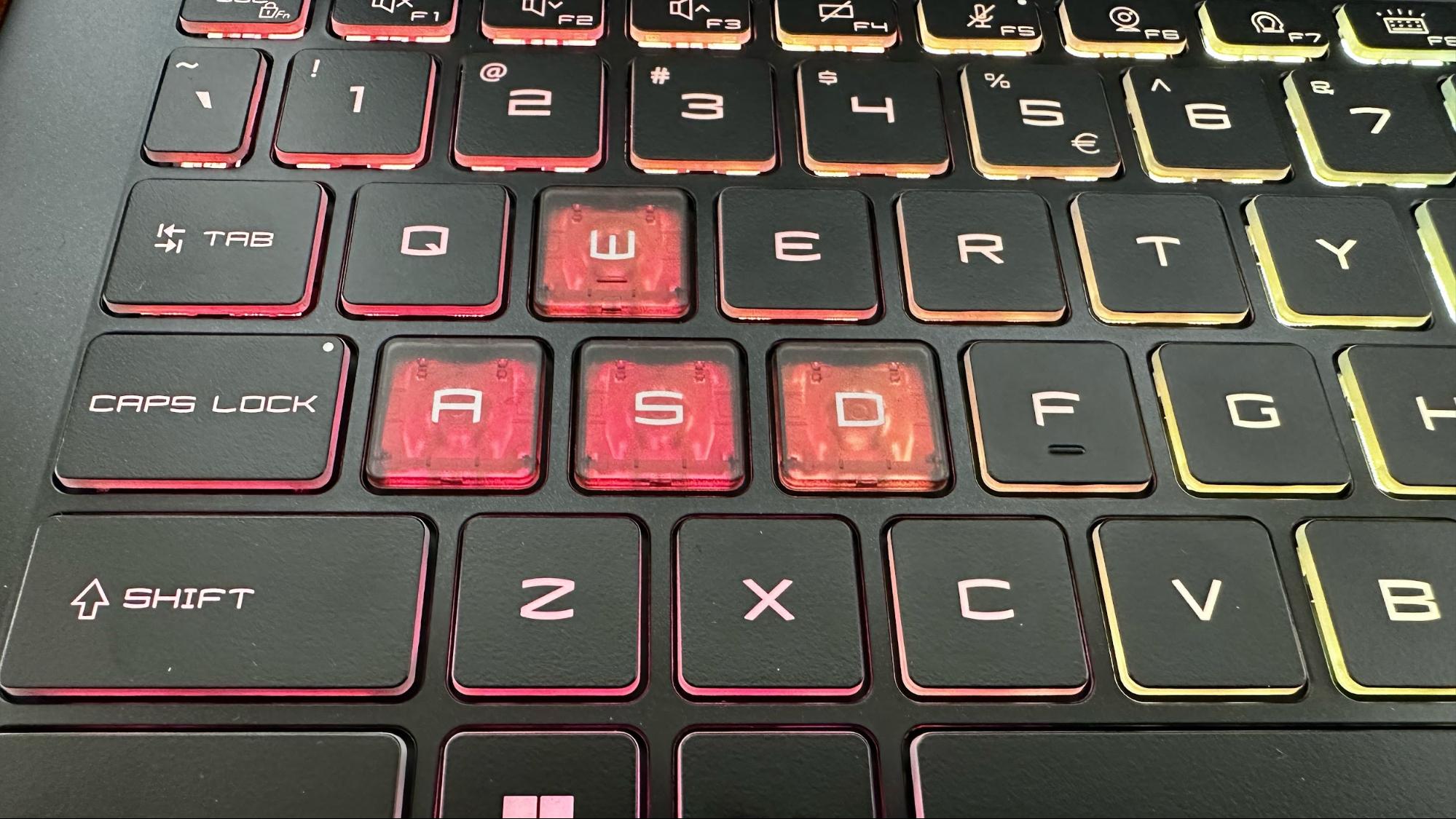
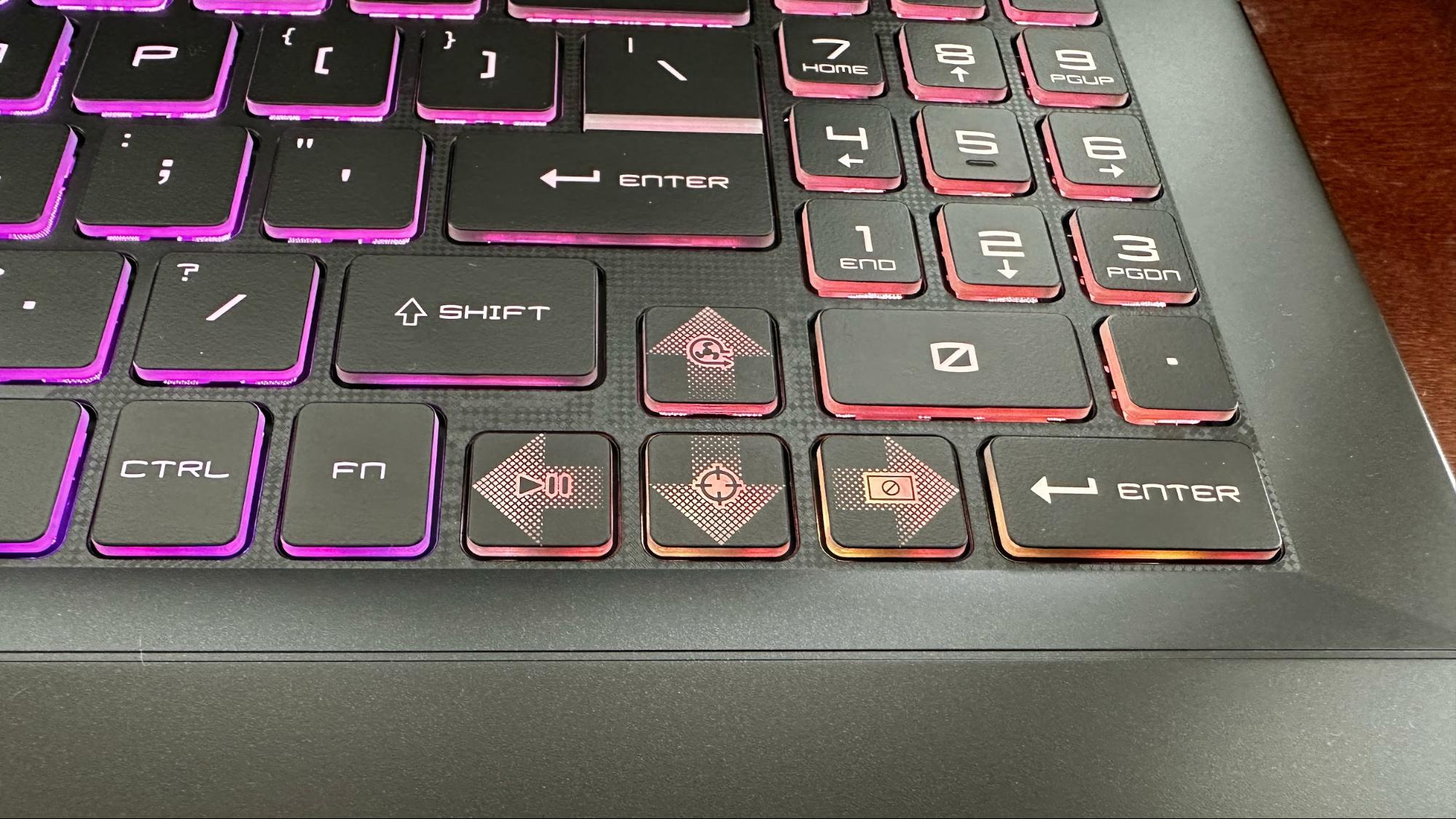
MSI attempts to be different with the transparent WASD and power keys, but the directional keys look garish and not in line with the laptop’s design. For those that like number pads, MSI squeezed in a narrow one here in the Katana 15.
I use keyhero.com for my typing tests and came away with 77.93 words per minute with 95.54 percent accuracy. For comparison, I achieved 85.43 wpm with the Lenovo IdeaPad Gaming 3 with a little under 90 percent accuracy.
The Katana 15 has a comparatively small touchpad, which measures just 2.6 x 4.1 inches. Nevertheless, I had no trouble navigating within Windows 11, although I wish it were a bit larger. With that said, I used an external mouse most of the time during my testing and exclusively for gaming.
Audio on the MSI Katana 15
The MSI Katana 15 comes equipped with a pair of 2-watt speakers, which are located up front under the palm rests, firing downward. The sound quality is decent, especially at this price point.
MSI includes Nahimic audio software, which allows you to change audio profiles for Music, Movie, Communication and Gaming. There’s also a Smart profile to dynamically change the audio settings based on the content being played.
I played John Mayer’s live performance of “Stop This Train” and was actually surprised at the clarity of the music. Even at high volume levels, there was little distortion to detract from the experience. Mayer’s voice was crisp and evocative, as was the melodic strumming of his acoustic guitar.
The overall enjoyable audio experience extended to Cyberpunk 2077 and Overwatch 2, with convincing sound from the firearms and clear speech from the in-game characters. However, we’d imagine that many gamers will forgo the speakers altogether and throw on a pair of the best gaming headsets available on the market.
Upgradeability of the MSI Katana 15
The Katana 15 is by no means a big laptop, but MSI uses a boatload of screws to secure the bottom panel to the chassis. We counted 13 Phillips head screws, which were thankfully easily removed. One of the screws was covered with a tamper warning sticker, so be aware if you want to perform your own upgrades and then need to return the laptop to MSI. We wish MSI would stop using these stickers.
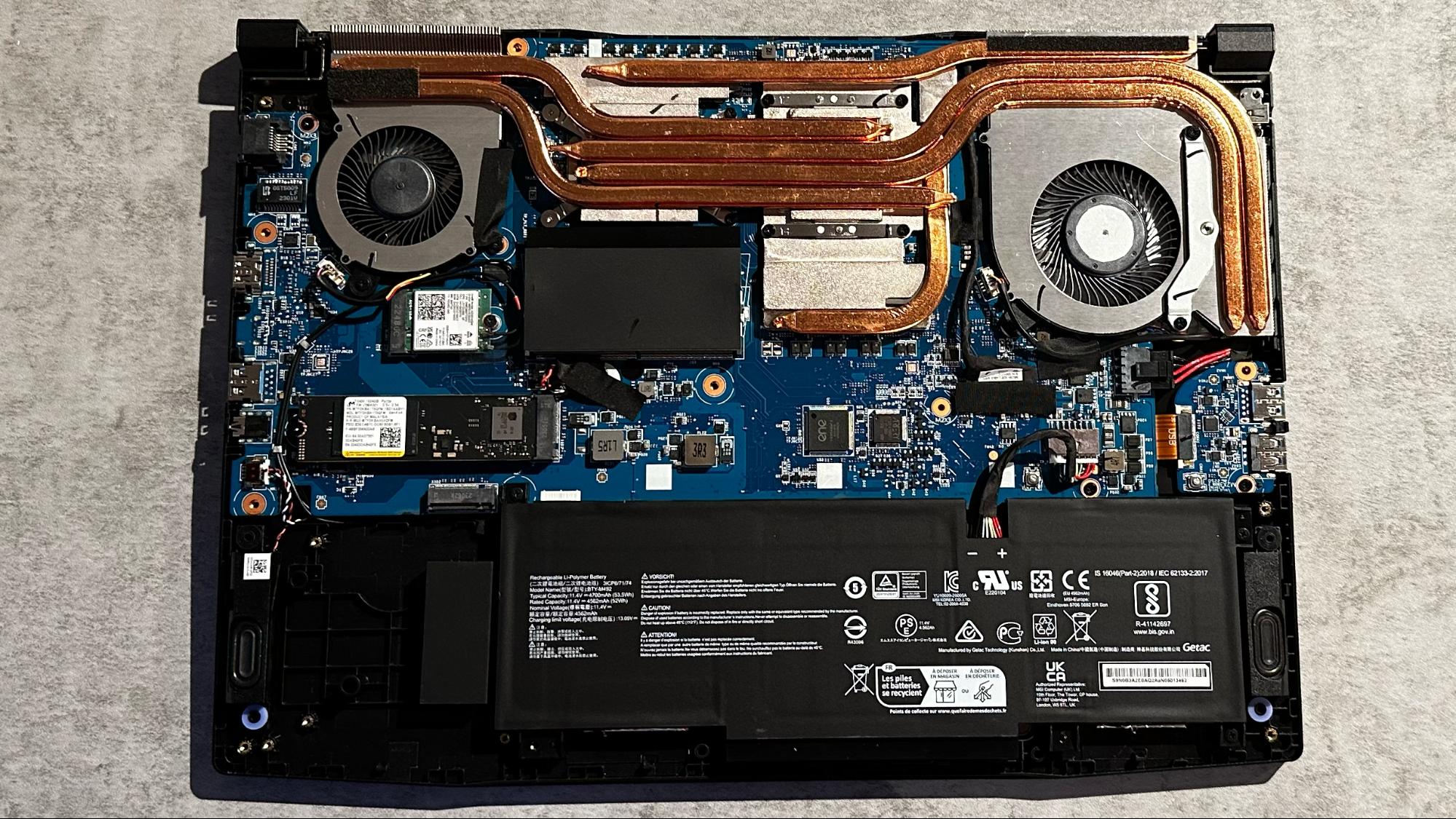
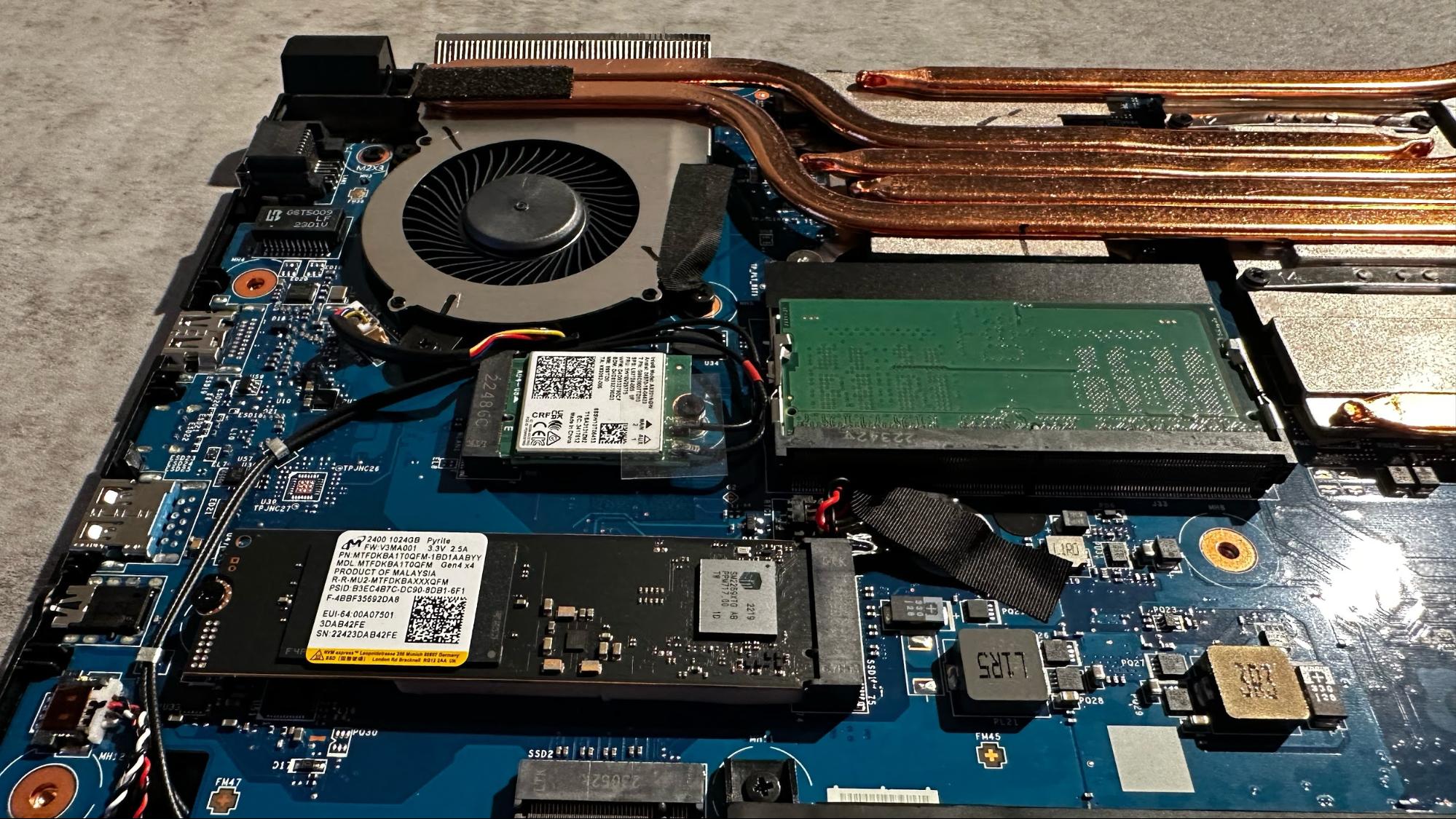
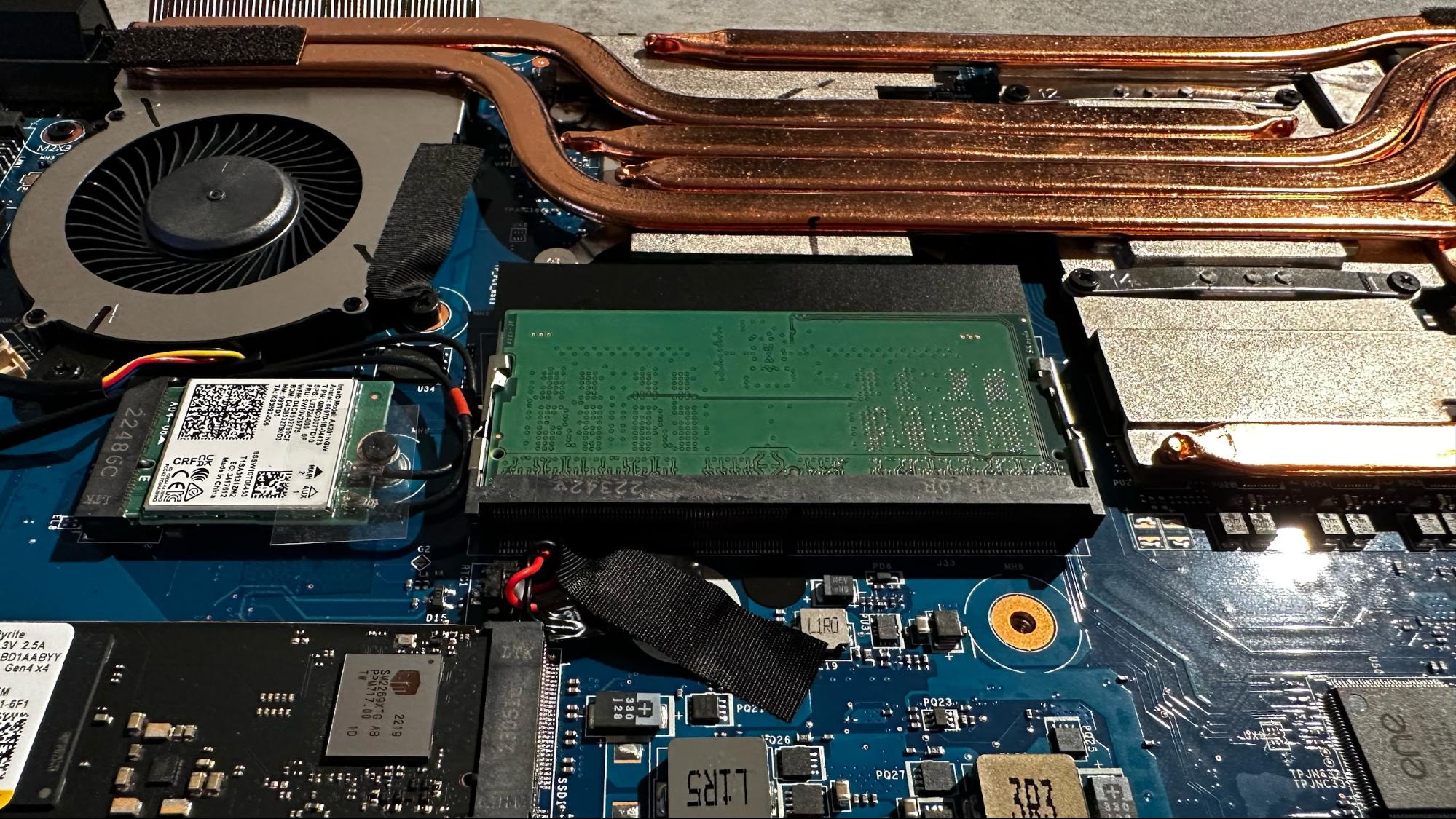
With the screws removed, the panel lifted off with ease, revealing a battery that is user-replaceable. There’s also easy access to the M.2 PCIe SSD and the Intel Wi-Fi 6 card. A plastic shield covers the two SO-DIMM slots. Both SO-DIMM slots were occupied in our review unit. However, we should caution that the Katana 15 doesn’t have provisions for a second M.2 slot for storage, so if you want to add a second SSD, you’re out of luck.
Battery Life on the MSI Katana 15
The Katana 15 has proven to be a performance champion in gaming and productivity benchmarks. However, that performance comes at the expense of battery life.
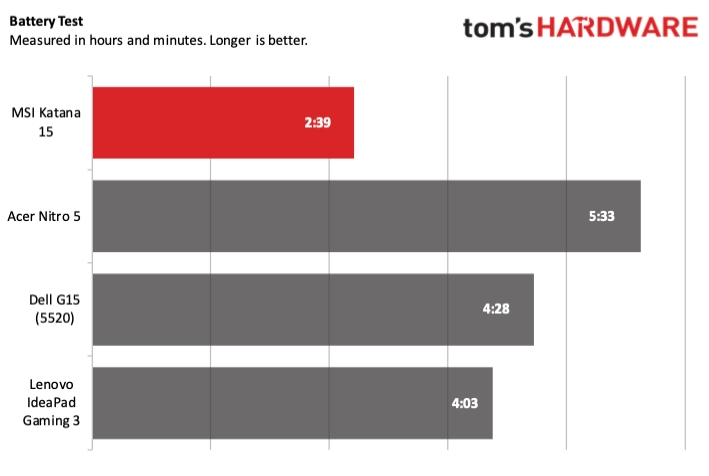
Our battery life benchmark consists of web browsing, light graphics work and video streaming while connected to Wi-Fi with display brightness set to 150 nits. Under these conditions, the Katana 15 only lasted two hours and 39 minutes on a charge. That was nearly an hour and a half shorter than the third-place Lenovo IdeaPad Gaming 3, which gave up after four hours and three minutes. On the other hand, the Acer Nitro 5 lasted the longest in this field at five hours and 33 minutes.
Part of this discrepancy is likely due to the 105-watt TDP GeForce RTX 4050 compared to the 95-watt RTX 3050 Ti. However, the Katana 15 can’t outrun the fact that it only has a 53.5 WHr battery. The Acer Nitro 5 and Dell G15 have slightly larger batteries.
Heat on the MSI Katana 15
We measure heat levels on gaming laptops after running the Metro Exodus benchmark over the course of 15 runs.
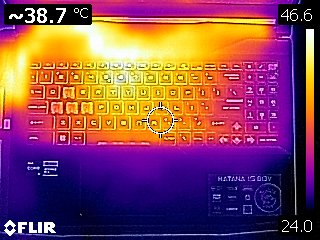
We measured 39.16 C (102.5 F) between the G and H keys on the keyboard, while the touchpad came in at just 27.22 C (81 F).
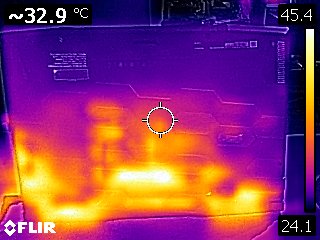
However, the hottest part of the laptop was on the bottom of the chassis near the hinge, which hit 45.77 (114.4 F).
Webcam on the MSI Katana 15
The Katana 15 uses a 720p webcam, and as you would expect, it is not very good. While many laptop OEMs accelerated the switch to 1080p webcams thanks to the work-from-home movement, laptops in the sub- $ 1,000 segment have largely yet to make the switch.
My face looked blurry, while background objects in the frame lacked the detail that you’ll find with 1080p webcams. In addition, there was an ever-present grain to the image, even in ideal lighting conditions. When the lights were dimmed in my office, the picture quality quickly took a nosedive. Look at grabbing one of the best webcams for a far better video conferencing or streaming quality.
Software and Warranty on the MSI Katana 15
The MSI Katana 15 isn’t nearly as cluttered with preinstalled software as some of the machines we’ve reviewed. You’ll find MSI Center, which allows you to monitor system vitals (CPU/GPU temperature, CPU/GPU clocks, etc.), enable gaming mode, and control the Mystic Light function of the RGB keyboard. The MSI App Player is an Android emulator that allows you to play Android games on your Windows PC. The only other notable addition is Nahimic audio software.
The are also the usual apps that come preinstalled on Windows 11 and the various app shortcuts that litter the Start menu like TikTok, ESPN, Prime Video and Spotify.
The Katana 15 comes with a one-year manufacturer warranty.
MSI Katana 15 Configurations
Our MSI Katana 15 review unit (B13VEK-277US) came equipped with an Intel Core i7-13620H processor, 16GB DDR5-5200 RAM (2 x 8GB modules), a 1TB PCIe SSD, Nvidia GeForce RTX 4050 GPU and a 15.6-inch 144Hz 1080p display. This configuration is priced at $999 and is available exclusively from Micro Center.
If you want a GeForce RTX 4070 GPU, you can get a configuration with a Core i7-13620H, 8GB of DDR5-5200 and a 1TB SSD for $1,599 from Amazon. A fully maxed-out configuration with an Intel Core i9-13900H, 32GB of DDR5-5200 (2x 16GB), and 1TB SSD is priced at $1,899 from Newegg.
Bottom Line
The MSI Katana 15 represents a great bargain in the budget gaming laptop field. With a street price of just under $1,000, the Katana 15 checks all the right boxes with a strong Core i7-13650H processor, 16GB of RAM and a 1TB SSD. That’s impressive given that many laptops similarly priced give you just 8GB of RAM and a 512GB SSD (or smaller).
We were also impressed with the GeForce RTX 4050, which is likely to be the new standard-bearer for low-priced gaming laptops, taking over the spot previously reserved for the RTX 3050 Ti. The Katana 15 swept the gaming benchmarks and did well in our productivity tests. It also impressed with its audio quality.
On the other hand, the display is mediocre at best, favoring a high refresh rate over image quality. In addition, the overall chassis doesn’t impart a high-quality feel, with plenty of flex and a shiny finish that screams “cheap.” One additional thing to consider is the short battery life, at just over two and a half hours. While we don’t expect gaming laptops to be endurance champs, the Katana 15’s runtime significantly lagged its peers. If runtimes away from a wall outlet are more of a priority for you, the Acer Nitro 5 would be a good alternative.
With that said, the Katana 15 ushers in the “new normal” for budget laptops powered by Raptor Lake and RTX 40 regarding performance. And it easily earns a spot among the best gaming laptops under $1,000.
MORE: How to Buy a Gaming Laptop
MORE: Best Gaming PCs







